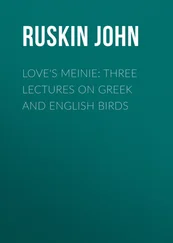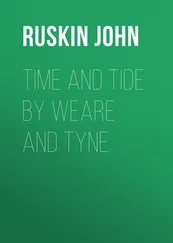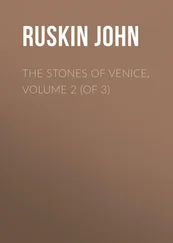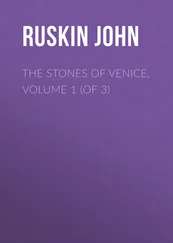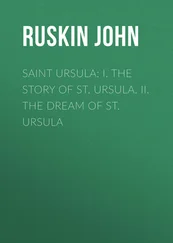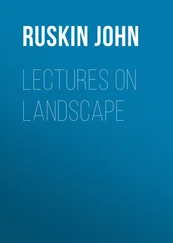John Ruskin - Proserpina, Volume 2
Здесь есть возможность читать онлайн «John Ruskin - Proserpina, Volume 2» — ознакомительный отрывок электронной книги совершенно бесплатно, а после прочтения отрывка купить полную версию. В некоторых случаях можно слушать аудио, скачать через торрент в формате fb2 и присутствует краткое содержание. Жанр: foreign_antique, Биология, literature_19, foreign_edu, на английском языке. Описание произведения, (предисловие) а так же отзывы посетителей доступны на портале библиотеки ЛибКат.
- Название:Proserpina, Volume 2
- Автор:
- Жанр:
- Год:неизвестен
- ISBN:нет данных
- Рейтинг книги:5 / 5. Голосов: 1
-
Избранное:Добавить в избранное
- Отзывы:
-
Ваша оценка:
- 100
- 1
- 2
- 3
- 4
- 5
Proserpina, Volume 2: краткое содержание, описание и аннотация
Предлагаем к чтению аннотацию, описание, краткое содержание или предисловие (зависит от того, что написал сам автор книги «Proserpina, Volume 2»). Если вы не нашли необходимую информацию о книге — напишите в комментариях, мы постараемся отыскать её.
Proserpina, Volume 2 — читать онлайн ознакомительный отрывок
Ниже представлен текст книги, разбитый по страницам. Система сохранения места последней прочитанной страницы, позволяет с удобством читать онлайн бесплатно книгу «Proserpina, Volume 2», без необходимости каждый раз заново искать на чём Вы остановились. Поставьте закладку, и сможете в любой момент перейти на страницу, на которой закончили чтение.
Интервал:
Закладка:
(6) Montana. Stays so.
(7) Odorata. Not distinctive;—nearly classical, however. It is to be our Viola Regina, else I should not have altered it.
(8) Palustris. Stays so.
(9) Tricolor. True, but intolerable. The flower is the queen of the true pansies: to be our Viola Psyche.
(10) Elatior. Only a variety of our already accepted Cornuta.
(11) The last is, I believe, also only a variety of Palustris. Its leaves, I am informed in the text, are either "pubescent-reticulate-venose-subreniform," or "lato-cordate-repando-crenate;" and its stipules are "ovate-acuminate-fimbrio-denticulate." I do not wish to pursue the inquiry farther.
24. These ten species will include, noting here and there a local variety, all the forms which are familiar to us in Northern Europe, except only two;—these, as it singularly chances, being the Viola Alpium, noblest of all the wild pansies in the world, so far as I have seen or heard of them,—of which, consequently, I find no picture, nor notice, in any botanical work whatsoever; and the other, the rock-violet of our own Yorkshire hills.
We have therefore, ourselves, finally then, twelve following species to study. I give them now all in their accepted names and proper order,—the reasons for occasional difference between the Latin and English name will be presently given.
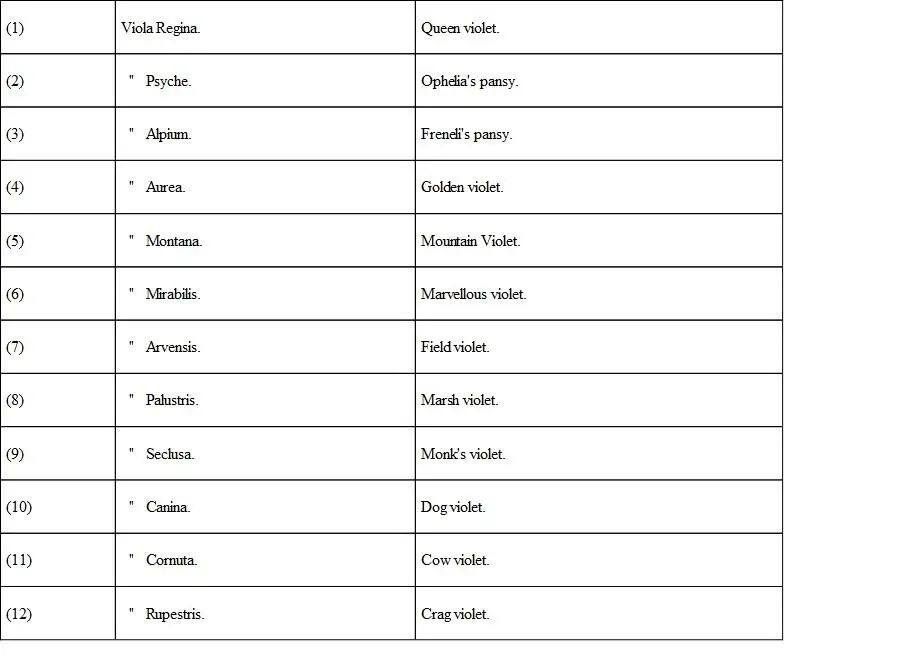
25. We will try, presently, what is to be found out of useful, or pretty, concerning all these twelve violets; but must first find out how we are to know which are violets indeed, and which, pansies.
Yesterday, after finishing my list, I went out again to examine Viola Cornuta a little closer, and pulled up a full grip of it by the roots, and put it in water in a wash-hand basin, which it filled like a truss of green hay.
Pulling out two or three separate plants, I find each to consist mainly of a jointed stalk of a kind I have not yet described,—roughly, some two feet long altogether; (accurately, one 1 ft. 10½ in.; another, 1 ft. 10 in.; another, 1 ft. 9 in.—but all these measures taken without straightening, and therefore about an inch short of the truth), and divided into seven or eight lengths by clumsy joints where the mangled leafage is knotted on it; but broken a little out of the way at each joint, like a rheumatic elbow that won't come straight, or bend farther; and—which is the most curious point of all in it—it is thickest in the middle, like a viper, and gets quite thin to the root and thin towards the flower; also the lengths between the joints are longest in the middle: here I give them in inches, from the root upwards, in a stalk taken at random.
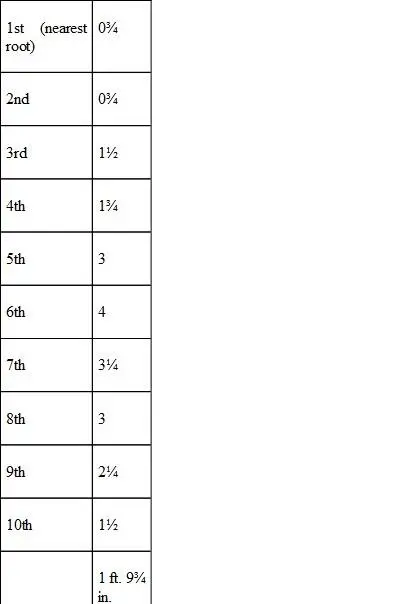
But the thickness of the joints and length of terminal flower stalk bring the total to two feet and about an inch over. I dare not pull it straight, or should break it, but it overlaps my two-foot rule considerably, and there are two inches besides of root, which are merely underground stem, very thin and wretched, as the rest of it is merely root above ground, very thick and bloated. (I begin actually to be a little awed at it, as I should be by a green snake—only the snake would be prettier.) The flowers also, I perceive, have not their two horns regularly set in , but the five spiky calyx-ends stick out between the petals—sometimes three, sometimes four, it may be all five up and down—and produce variously fanged or forked effects, feebly ophidian or diabolic. On the whole, a plant entirely mismanaging itself,—reprehensible and awkward, with taints of worse than awkwardness; and clearly, no true 'species,' but only a link. 2 2 See 'Deucalion,' vol. ii., chap, i., p. 12, § 18.
And it really is, as you will find presently, a link in two directions; it is half violet, half pansy, a 'cur' among the Dogs, and a thoughtless thing among the thoughtful. And being so, it is also a link between the entire violet tribe and the Runners—pease, strawberries, and the like, whose glory is in their speed; but a violet has no business whatever to run anywhere, being appointed to stay where it was born, in extremely contented (if not secluded) places. "Half-hidden from the eye?"—no; but desiring attention, or extension, or corpulence, or connection with anybody else's family, still less.

FIG. II.
26. And if, at the time you read this, you can run out and gather a true violet, and its leaf, you will find that the flower grows from the very ground, out of a cluster of heart-shaped leaves, becoming here a little rounder, there a little sharper, but on the whole heart-shaped, and that is the proper and essential form of the violet leaf. You will find also that the flower has five petals; and being held down by the bent stalk, two of them bend back and up, as if resisting it; two expand at the sides; and one, the principal, grows downwards, with its attached spur behind. So that the front view of the flower must be some modification of this typical arrangement, Fig. M, (for middle form). Now the statement above quoted from Figuier, § 16, means, if he had been able to express himself, that the two lateral petals in the violet are directed downwards, Fig. II. A, and in the pansy upwards, Fig. II. C. And that, in the main, is true, and to be fixed well and clearly in your mind. But in the real orders, one flower passes into the other through all kinds of intermediate positions of petal, and the plurality of species are of the middle type. Fig. II. B. 3 3 I am ashamed to give so rude outlines; but every moment now is valuable to me: careful outline of a dog-violet is given in Plate X.
27. Next, if you will gather a real pansy leaf , you will find it—not heart-shape in the least, but sharp oval or spear-shape, with two deep cloven lateral flakes at its springing from the stalk, which, in ordinary aspect, give the plant the haggled and draggled look I have been vilifying it for. These, and such as these, "leaflets at the base of other leaves" (Balfour's Glossary), are called by botanists 'stipules.' I have not allowed the word yet, and am doubtful of allowing it, because it entirely confuses the student's sense of the Latin 'stipula' (see above, vol. i., chap. viii., § 27) doubly and trebly important in its connection with 'stipulor,' not noticed in that paragraph, but readable in your large Johnson; we shall have more to say of it when we come to 'straw' itself.
28. In the meantime, one may think of these things as stipulations for leaves, not fulfilled, or 'stumps' or 'sumphs' of leaves! But I think I can do better for them. We have already got the idea of crested leaves, (see vol. i., plate); now, on each side of a knight's crest, from earliest Etruscan times down to those of the Scalas, the fashion of armour held, among the nations who wished to make themselves terrible in aspect, of putting cut plates or 'bracts' of metal, like dragons' wings, on each side of the crest. I believe the custom never became Norman or English; it is essentially Greek, Etruscan, or Italian,—the Norman and Dane always wearing a practical cone (see the coins of Canute), and the Frank or English knights the severely plain beavered helmet; the Black Prince's at Canterbury, and Henry V.'s at Westminster, are kept hitherto by the great fates for us to see. But the Southern knights constantly wore these lateral dragon's wings; and if I can find their special name, it may perhaps be substituted with advantage for 'stipule'; but I have not wit enough by me just now to invent a term.
Читать дальшеИнтервал:
Закладка:
Похожие книги на «Proserpina, Volume 2»
Представляем Вашему вниманию похожие книги на «Proserpina, Volume 2» списком для выбора. Мы отобрали схожую по названию и смыслу литературу в надежде предоставить читателям больше вариантов отыскать новые, интересные, ещё непрочитанные произведения.
Обсуждение, отзывы о книге «Proserpina, Volume 2» и просто собственные мнения читателей. Оставьте ваши комментарии, напишите, что Вы думаете о произведении, его смысле или главных героях. Укажите что конкретно понравилось, а что нет, и почему Вы так считаете.




